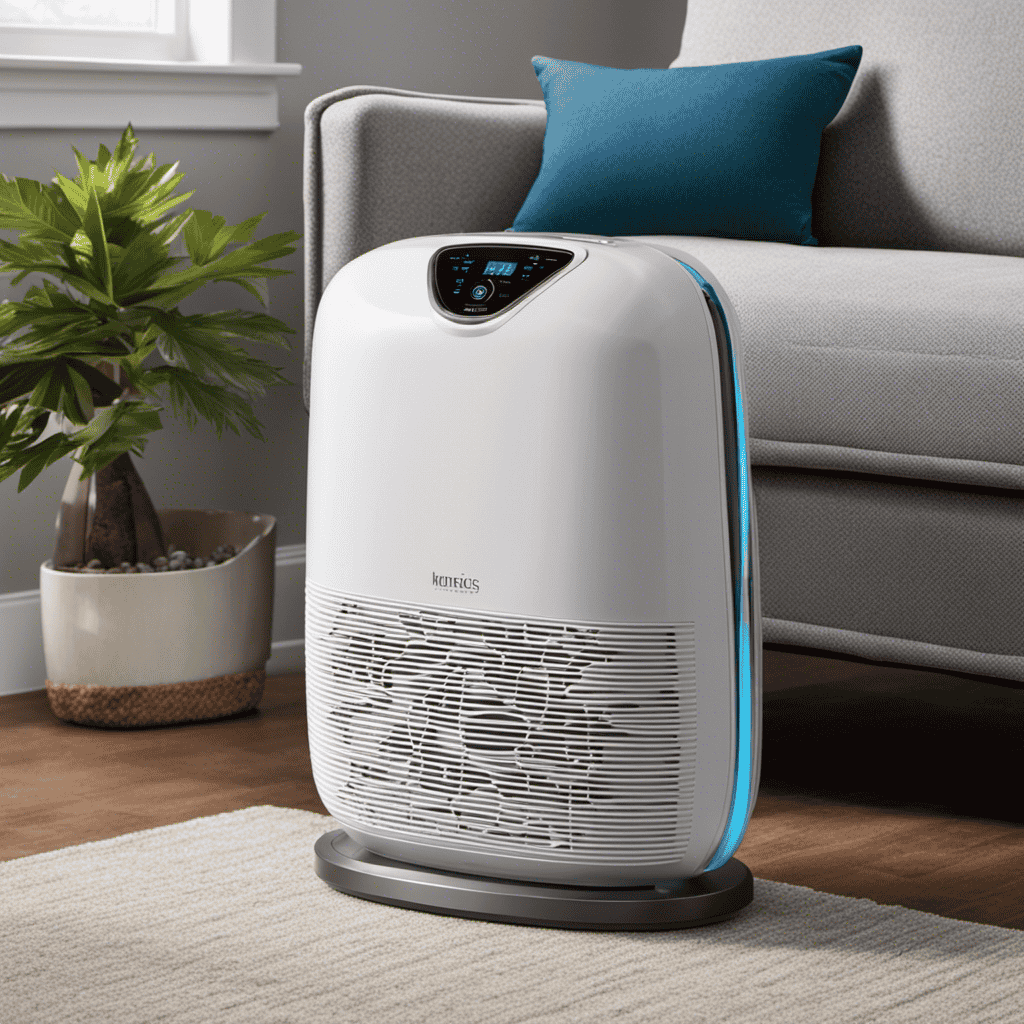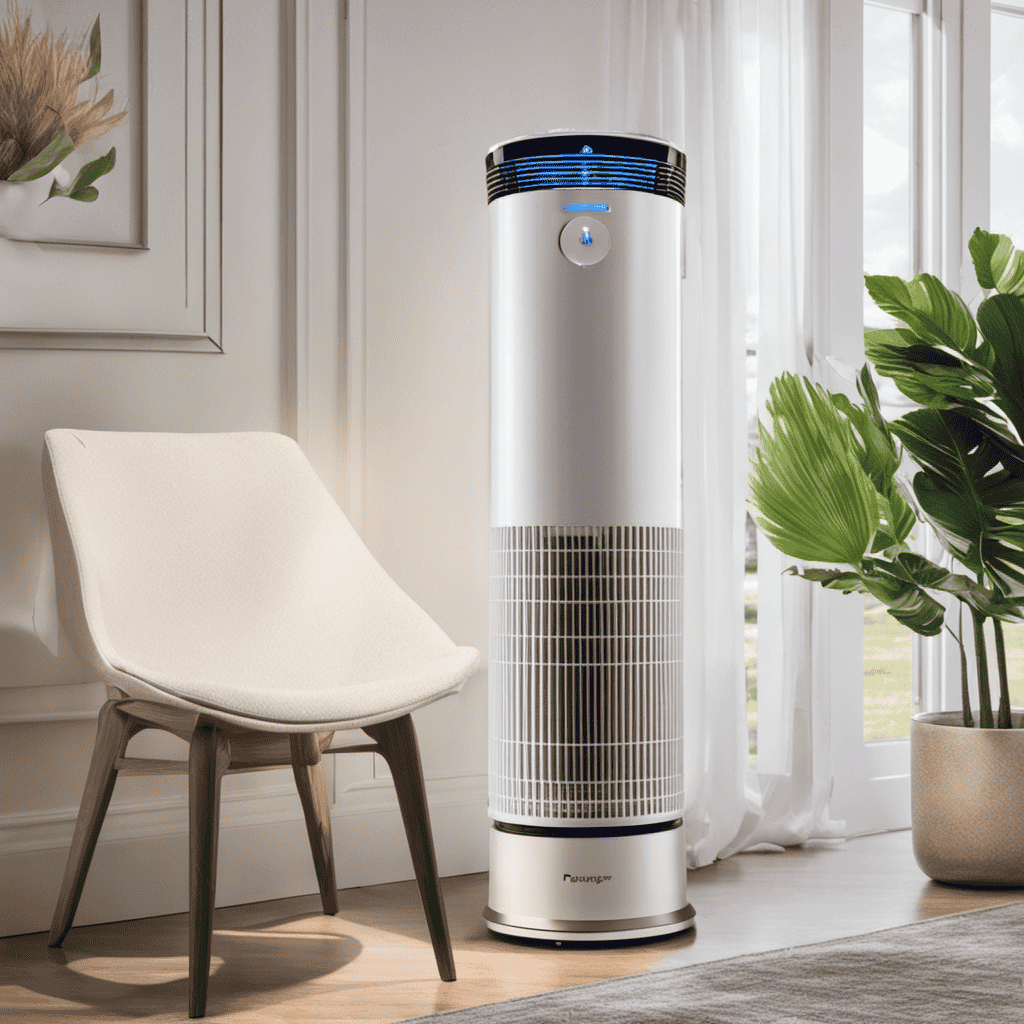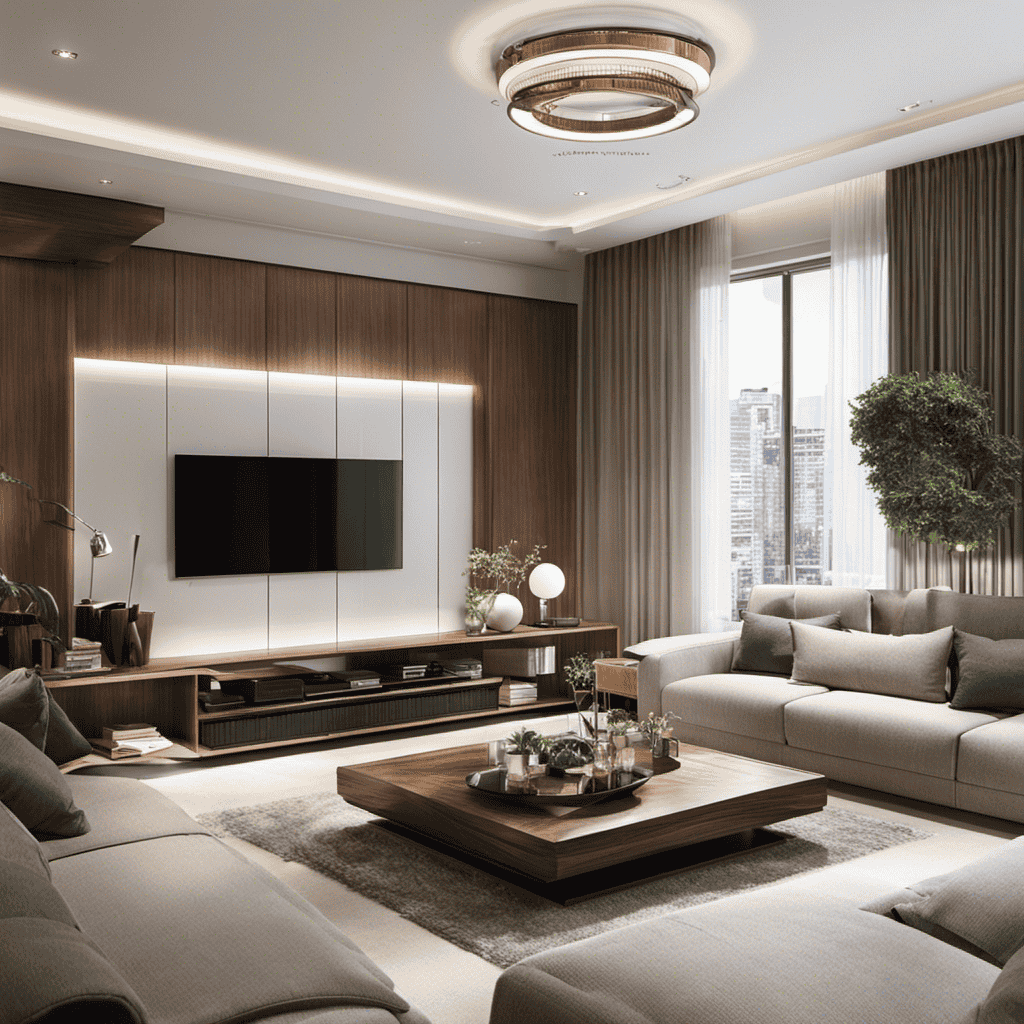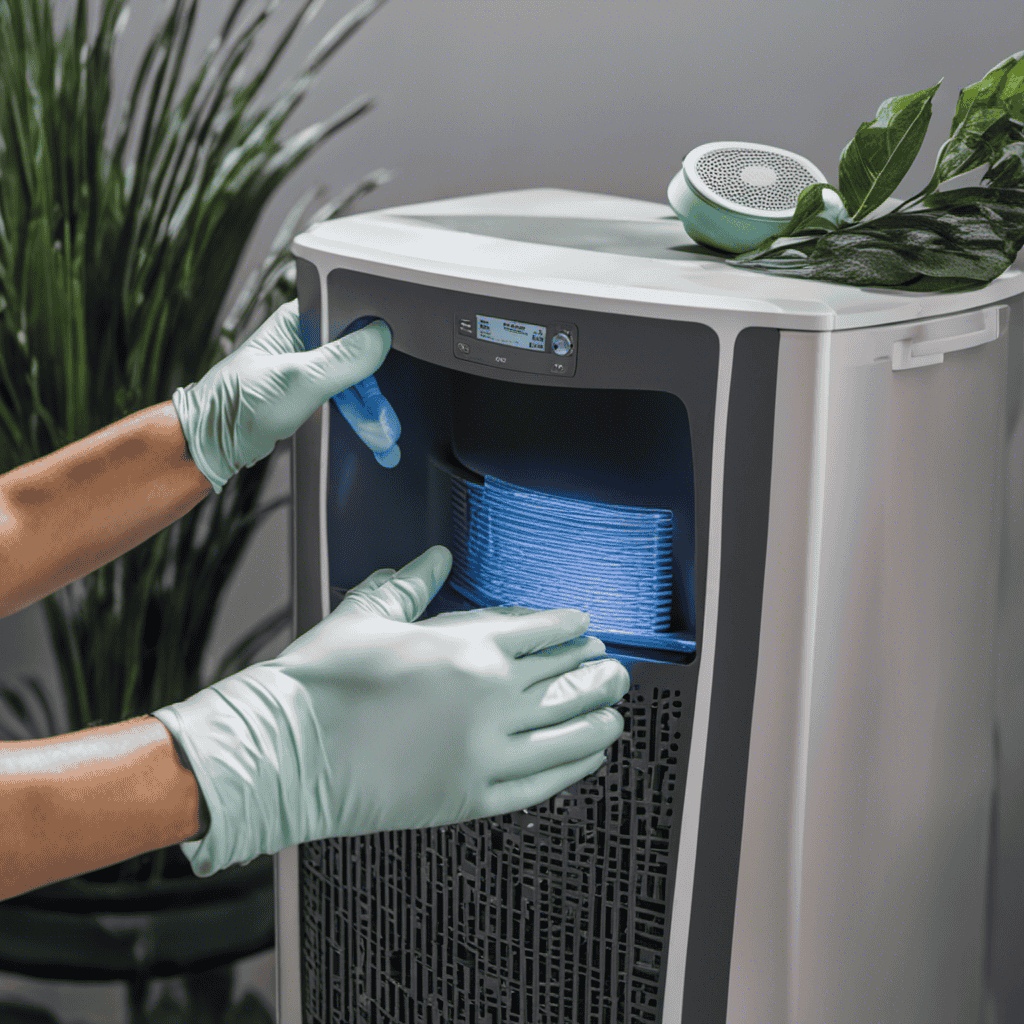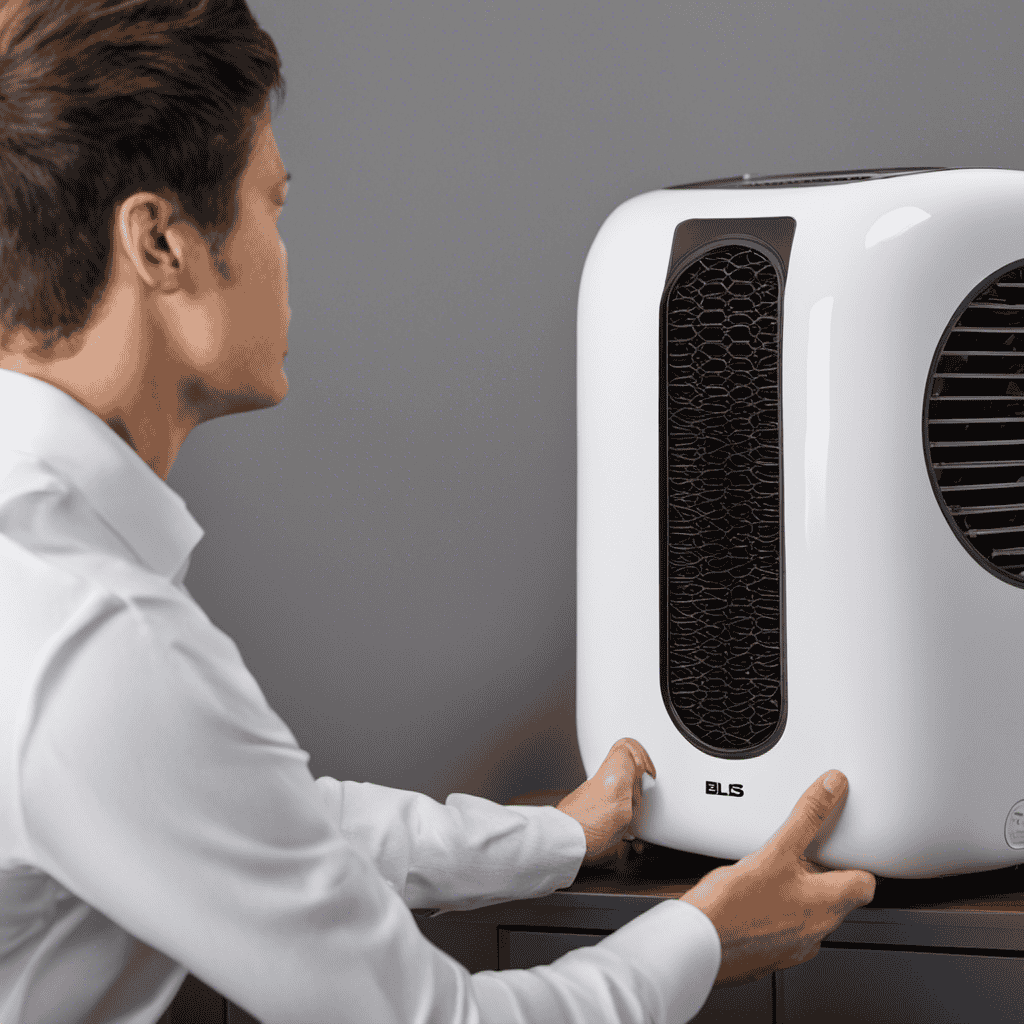I have always had trouble with indoor air quality, but ever since I began using the Homedics Totalclean Air Purifier, I have seen a remarkable difference.
Did you know that the average person spends about 90% of their time indoors, where the air can be up to five times more polluted than outdoor air? That’s why it’s essential to have a reliable air purifier like the Homedics Totalclean.
In this article, I’ll guide you through the proper usage of this device, so you can breathe cleaner and healthier air in your home.
Key Takeaways
- The article will cover the unboxing, setup, and understanding of the control panel of the Homedics Totalclean Air Purifier.
- Troubleshooting common issues, replacing filters, using the timer function, and cleaning and maintaining the air purifier will also be discussed.
- The article will explain adjusting fan speed, selecting the correct mode, and provide mode selection tips for optimal air purification.
- The importance of adjusting fan speed control, choosing the appropriate mode based on air pollution level, ensuring effective pollutant and allergen removal, and paying attention to filter replacement frequency will be highlighted.
Unboxing and Initial Setup
Let’s start by unboxing the Homedics TotalClean air purifier and getting it set up for use.
When you receive your air purifier, carefully remove it from the packaging, making sure to keep all the components intact. Inside the box, you will find the main unit, a set of filters, and a user manual.
Begin by locating the filter compartment on the back of the unit. Open it up and insert the filters, ensuring they are properly aligned.
Once the filters are in place, plug in the air purifier and turn it on. You can adjust the fan speed and set the timer according to your preference.
It’s important to note that you should regularly clean and replace the filters to maintain optimal performance.
With these simple unboxing tips and initial setup instructions, you’ll have your Homedics TotalClean air purifier ready to improve the air quality in your space.
Understanding the Control Panel
Now that you’ve unboxed and set up your Homedics TotalClean Air Purifier, let’s dive into understanding the control panel.
In this discussion, we’ll explore the various functions of the panel, providing you with a comprehensive explanation of each one.
Additionally, we’ll give you an overview of the different setting options available and how they can be customized to suit your needs.
And finally, we’ll address common troubleshooting issues that may arise, ensuring that you have the knowledge to resolve any problems that may occur.
Panel Functions Explained
The panel functions on the HoMedics TotalClean air purifier are clearly explained in the user manual. The control panel of the air purifier is designed to be user-friendly and intuitive. It features several buttons and indicators that allow you to easily operate and monitor the device. Here is a breakdown of the panel features and their operating instructions:
| Panel Feature | Operating Instructions |
|---|---|
| Power Button | Press to turn the device on or off. |
| Fan Speed Button | Press to adjust the fan speed to your desired level (Low, Medium, High). |
| Timer Button | Press to set the timer for automatic shut-off after a certain period of time. |
| Filter Indicator | Lights up when it’s time to replace the filter. |
| UV-C Light Button | Press to turn on/off the UV-C light feature for additional air purification. |
Understanding these panel functions will help you effectively use the HoMedics TotalClean air purifier. Now, let’s move on to the next section for an overview of the setting options.
Setting Options Overview
The HoMedics TotalClean air purifier offers various setting options for customized use.
With this air purifier, you have the flexibility to adjust the fan speed and choose between different modes such as Sleep, Auto, and Manual.
The Sleep mode operates quietly to ensure a peaceful night’s sleep while still purifying the air.
The Auto mode automatically adjusts the fan speed based on the air quality sensor readings, ensuring efficient performance.
In Manual mode, you can manually control the fan speed to suit your preferences.
It is important to note the filter replacement schedule for optimal performance.
The TotalClean air purifier has a filter replacement indicator that alerts you when it’s time to replace the filter, ensuring clean and fresh air at all times.
Additionally, the air quality sensor accuracy ensures that the purifier responds accurately to changes in air quality, guaranteeing effective purification.
Troubleshooting Common Issues
Having trouble with your air purifier? Let’s troubleshoot some common issues together. Here are some troubleshooting tips and techniques to help you get your Homedics TotalClean Air Purifier up and running smoothly:
-
Check the power source: Ensure that the air purifier is properly plugged in and the power switch is turned on. Sometimes a loose connection can cause the purifier to stop working.
-
Clean the filters: Over time, the filters can become clogged with dust and debris, reducing their effectiveness. Regularly clean or replace the filters to maintain optimal performance.
-
Reset the unit: If the air purifier is not responding or seems to be malfunctioning, try resetting it by unplugging it from the power source for a few minutes, then plugging it back in.
-
Contact customer support: If none of the above troubleshooting techniques work, it’s best to reach out to the manufacturer’s customer support for further assistance.
Adjusting the Fan Speed
To adjust the fan speed on the Homedics TotalClean air purifier, simply press the speed button.
This air purifier offers multiple fan speed options, allowing you to customize the airflow to your preference. By adjusting the fan speed, you can also control the noise level produced by the device.
The Homedics TotalClean air purifier typically comes with three or four fan speed settings, ranging from low to high. The low-speed setting is ideal for quieter operation, making it suitable for use during sleep or in quiet environments.
On the other hand, the high-speed setting provides maximum air circulation and is more suitable for larger rooms or areas with high levels of pollutants.
Experiment with different fan speed options to find the perfect balance between air purification and noise level in your space.
Selecting the Correct Mode
When it comes to selecting the correct mode for your air purifier, there are a few key tips to keep in mind.
First, consider the specific needs of your environment, such as allergies, odors, or pet dander.
Next, familiarize yourself with the different mode options available on your purifier and their corresponding functions.
Lastly, choose the mode that best addresses your unique needs and enjoy the benefits of cleaner, fresher air in your space.
Mode Selection Tips
For optimal results, it’s important to select the appropriate mode on the HoMedics TotalClean air purifier. By doing so, you can reap the full benefits of mode selection and optimize the air purification process. Here are some tips to help you make the right choice:
-
Consider the room size: Different modes are designed to work efficiently in different room sizes. Selecting the mode that matches your room dimensions will ensure effective purification.
-
Analyze the air quality: The TotalClean air purifier has sensors that monitor the air quality. Use this information to choose the mode that best suits the current conditions in your environment.
-
Customize the settings: Some modes allow you to adjust settings like fan speed and timer. Take advantage of these options to tailor the purification process to your specific needs.
-
Experiment and observe: Try different modes and observe how they affect the air quality. This will help you identify the mode that consistently delivers the best results.
By following these tips, you can optimize the air purification process and create a healthier living environment.
Now, let’s explore the best mode options for the HoMedics TotalClean air purifier.
Best Mode Options
Choosing the best mode options is essential for maximizing the effectiveness of your air purification process. When using the Homedics TotalClean Air Purifier, you have the flexibility to adjust the fan speed control according to your needs. The fan speed control allows you to choose between low, medium, and high settings, depending on the level of air pollution in your surroundings.
By selecting the appropriate mode, you can ensure that the air purifier is working at its optimum capacity to remove pollutants and allergens from the air.
Additionally, it is important to pay attention to the filter replacement frequency. Regularly replacing the filters will help maintain the efficiency of the air purifier and ensure that it continues to provide clean and fresh air for your home or office.
Now, let’s explore the process of replacing the filters.
Replacing the Filters
To replace the filters on the HoMedics TotalClean air purifier, simply follow these steps:
- Turn off the air purifier and unplug it from the power source.
- Locate the filter compartment on the back of the unit.
- Open the compartment by pressing the latch or sliding it open, depending on the model.
- Remove the old filters and discard them properly.
Replacing the filters is an essential part of filter maintenance for the HoMedics TotalClean air purifier. Over time, the filters become clogged with pollutants and lose their effectiveness. By regularly replacing the filters, you ensure that your air purifier continues to provide clean and fresh air.
The frequency of filter replacement depends on the air quality in your environment and the usage of the purifier. It’s recommended to check the filters every three to six months and replace them as needed.
Follow these simple steps to maintain optimal performance and enjoy the benefits of clean air in your home.
Using the Timer Function
Make sure you set the timer on your HoMedics TotalClean air purifier so that it automatically turns off after a certain amount of time. The timer settings allow you to customize how long you want the purifier to run before it shuts off. This is especially useful if you want to conserve energy or if you only need the purifier to run for a specific period.
The TotalClean air purifier offers programmable timer options, allowing you to choose from preset time intervals or manually set the timer to your desired length. By utilizing the timer function, you can have peace of mind knowing that your air purifier will automatically turn off according to your preferences.
Understanding the filter indicator lights is equally essential to ensure the optimal performance of your air purifier.
Understanding the Filter Indicator Lights
Understanding the filter indicator lights is crucial for knowing when to replace the filters on your HoMedics TotalClean air purifier. These indicator lights are designed to inform you about the condition of your filters and ensure that you are breathing in clean, purified air.
Here are four key things to know about the filter indicator lights:
-
Cleaning Indicator: The cleaning indicator light will illuminate when the filters need to be cleaned. This indicates that the filters have accumulated a significant amount of dirt and need to be cleaned to maintain optimal performance.
-
Filter Replacement Intervals: The filter indicator lights will also indicate when it’s time to replace the filters. Different filters have different replacement intervals, so it’s important to refer to the user manual for specific guidance.
-
Regular Maintenance: Regularly checking the filter indicator lights and performing maintenance tasks, such as cleaning or replacing filters, will ensure that your air purifier continues to effectively remove contaminants from the air.
-
Improved Air Quality: By paying attention to the filter indicator lights and promptly cleaning or replacing filters as needed, you can ensure that your HoMedics TotalClean air purifier is working at its best, providing you with cleaner and healthier air to breathe.
Cleaning and Maintaining the Air Purifier
Regularly cleaning and maintaining your air purifier is essential for ensuring optimal performance and clean, purified air. By following a few simple cleaning tips, you can keep your air purifier running efficiently and effectively. Here are some maintenance tasks and cleaning tips to help you maintain your air purifier:
| Maintenance Task | Cleaning Tip | Frequency |
|---|---|---|
| Replace the filter | Follow the manufacturer’s instructions | As recommended |
| Clean the exterior | Wipe with a soft cloth and mild detergent | Monthly |
| Vacuum the vents | Use a brush attachment to remove dust | Every 2-3 months |
These maintenance tasks will help prolong the life of your air purifier and ensure that it continues to provide you with clean, purified air. Remember to always refer to the manufacturer’s instructions for specific cleaning guidelines and recommendations. By taking care of your air purifier, you can enjoy fresh and clean air in your home for years to come.
Troubleshooting Common Issues
If your air purifier is not functioning properly, there are a few common issues you can troubleshoot to identify and resolve the problem. Here are some troubleshooting tips to help you out:
-
Check the power source: Ensure that the air purifier is properly plugged in and receiving power. Sometimes, a loose connection can cause the unit to malfunction.
-
Clean or replace the filter: A clogged or dirty filter can hinder the air purifier’s performance. Clean or replace the filter regularly to maintain optimal air quality.
-
Check for obstructions: Make sure there are no objects blocking the air intake or outlet vents. Blocked vents can restrict airflow and affect the purifier’s efficiency.
-
Reset the unit: If all else fails, try resetting the air purifier to its factory settings. This can sometimes resolve minor issues and restore normal functionality.
Frequently Asked Questions
How Often Should I Replace the Filters in the Homedics Totalclean Air Purifier?
I replace the filters in my Homedics Totalclean Air Purifier every 6 months. Signs that indicate the filters need to be replaced include reduced airflow and a noticeable decrease in air quality.
Can I Use the Air Purifier in a Room With Pets?
Yes, you can use an air purifier in a room with pets. It helps to remove pet dander, allergens, and odors, creating a cleaner and healthier environment for both you and your furry friends.
Is It Safe to Use the Air Purifier While I Am Sleeping?
Yes, it is safe to use the air purifier while I am sleeping. The noise levels are low, ensuring a peaceful sleep. Using an air purifier while sleeping provides numerous benefits, such as improving air quality and reducing allergens.
Can the Air Purifier Remove Cigarette Smoke and Odors?
Yes, the air purifier can effectively remove cigarette smoke and odors. It’s important to regularly maintain the purifier to ensure optimal performance. Air purifiers have numerous benefits, including improving air quality and reducing allergens.
How Long Does It Take for the Air Purifier to Clean the Air in a Room?
It typically takes the air purifier a few hours to clean the air in a room. The effectiveness of the air purifier depends on factors like room size and air quality. Using an air purifier has many benefits, such as removing allergens and improving overall air quality.
Conclusion
In conclusion, the HoMedics TotalClean Air Purifier is not just your average purifier. Its advanced features and user-friendly design make it a standout among its competitors.
But here’s the real kicker: with its powerful filtration system, it not only removes allergens and pollutants from the air, but also eliminates up to 99.97% of airborne particles.
So, if you’re looking for an air purifier that goes above and beyond, look no further. The HoMedics TotalClean Air Purifier is the one for you.
